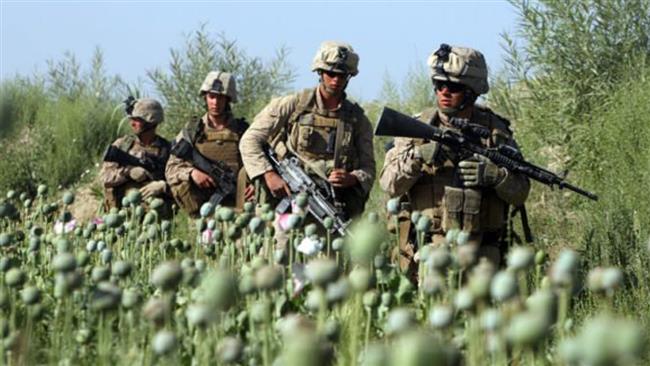
We Should all be Taking a Knee for this: Tax Dollars Spent in Afghanistan Have Boosted Opium Production
America has a terrible heroin epidemic throughout the country. Not just heroin, pharma’s role is just as prevalent with the opioid epidemic. America is in the grip of a heroin and prescription-drug epidemic. More Americans – almost 50,000 per year – now die from drugs than from guns or in car accidents. What I’m focusing on today is the government’s own report literally proving YOUR TAX DOLLARS are being spent in Afghanistan are boosting HEROIN PRODUCTION.
The recent report from the Special Inspector General for Afghanistan Reconstruction (SIGAR) reveals that U.S. taxpayers spent $8.62 billion in Afghanistan between 2002 and 2017—solely on combating poppy cultivation and drug production. The result was an absolute failure, and the report confirmed that “Afghanistan remains the world’s largest opium producer, and opium poppy is the country’s largest cash crop.”
SIGAR’s analysis revealed that no counternarcotics program led to lasting reductions in poppy cultivation or opium production. Eradication efforts had no lasting impact, and eradication was not consistently conducted in the same geographic locations as development assistance. Alternative-development programs were often too short-term, failed to provide sustainable alternatives to poppy, and sometimes evencontributed to poppy production.
The report also claimed that “the Afghan drug trade has undermined reconstruction and security, including by financing insurgent groups and fueling government corruption.”
Before the U.S. invaded Afghanistan in 2001, poppy cultivation was actually at a low. Now, as the war rages on with no end in sight, production has reached an all-time high.
The heroin epidemic resembles the days when “Crack cocaine” became the major drug that destroyed communities across the United States and other parts of the world including the Caribbean that began in the early 1980’s. The Crack epidemic coincidentally began around the same time when the Iran-Contra Scandal was being exposed. U.S. cities such as Los Angeles, Miami and New York City experienced a rise in crime and disease. The Center for Disease Control (CDC) reported back in 2015 that “heroin use in the United States increased 63% from 2002 through 2013.”
The Washington Post admitted in 2006 that heroin production in Afghanistan “broke all records” while under U.S. occupation:
Opium production in Afghanistan, which provides more than 90 percent of the world’s heroin, broke all records in 2006, reaching a historic high despite ongoing U.S.-sponsored eradication efforts, the Bush administration reported yesterday.
In addition to a 26 percent production increase over past year — for a total of 5,644 metric tons — the amount of land under cultivation in opium poppies grew by 61 percent. Cultivation in the two main production provinces, Helmand in the southwest and Oruzgan in central Afghanistan, was up by 132 percent
However, not only heroin from Afghanistan is the major source for U.S. citizens, “Big Pharma”, or the ‘corporate drug dealers’ who sell “legal drugs” also have a hand in the epidemic because they produce and sell ‘Opioids’ such as OxyContin and Percocet which is similar to heroin.
Under supervision from the U.S., Afghanistan is now responsible for producing 90 percent of the world’s opium supply, and the massive increase in production has fueled an on-going opioid crisis in the United States that has ensnared more than 2.5 million Americans in heroin addiction.
As whistleblower and former FBI contractor Sibel Edmonds noted, before the U.S. invaded Afghanistan in 2001, there were around 189,000 heroin users in the United States. By 2016, that figure increased to 4.5 million—an estimated 2.5 million heroin addicts and 2 million casual users.
The online news source The Huffington Post published an article titled ‘Ron Paul Had Accurate Conspiracy Theory: CIA Was Tied To Drug Traffickers’ highlights what the former Libertarian Presidential nominee Dr. Ron Paul said on the involvement of the CIA in the drug trade which was not a “Conspiracy Theory” but a fact when taking into consideration the Iran-Contra Scandal:
Drug trafficking is “a gold mine for people who want to raise money in the underground government in order to finance projects that they can’t get legitimately. It is very clear that the CIA has been very much involved with drug dealings,” Paul said. “The CIA was very much involved in the Iran-Contra scandals. I’m not making up the stories; we saw it on television. They were hauling down weapons and drugs back. And the CIA and government officials were closing their eyes, fighting a war that was technically illegal.”
The latest report from SIGAR clearly states after 15 years “no counternarcotics program led to lasting reductions in poppy cultivation or opium production.” Instead, U.S. efforts have actually contributed to opium production and made the problem worse. The report claims that “improved security, governance, and economic growth” are needed to make a lasting difference, which means that after spending more than $1 trillion, the government still believes throwing money at the problem is what is needed to solve it.
How long will the average American continue to pay their taxes like a good little slave and glorify our military that is directly involved in this crisis we have on our hands? The federal reserve bank and the CIA. They have to go or this is going to get much much worse.
Sources:
source:https://www.activistpost.com/2018/08/governments-own-report-shows-tax-dollars-spent-in-afghanistan-have-boosted-opium-production.html

 My First Amazing Ayahuasca Experience
My First Amazing Ayahuasca Experience  Pine Needle Tea
Pine Needle Tea  The REAL Controllers of Humanity: The Papal Bloodlines
The REAL Controllers of Humanity: The Papal Bloodlines  Is it Global Warming or Cooling?
Is it Global Warming or Cooling?  Gun Rights and Obama Examined
Gun Rights and Obama Examined